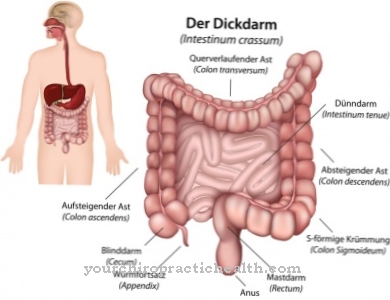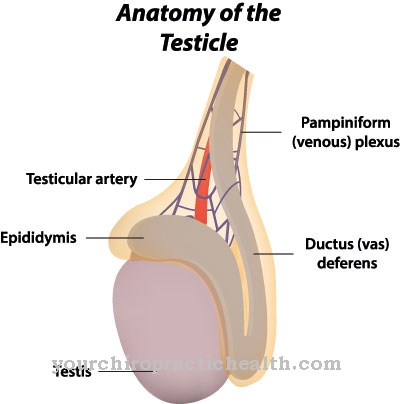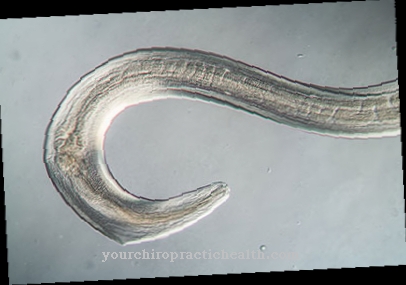The Carpal tunnel syndrome is pressure damage to nerves in the wrist caused by a tightness in the carpal canal. The disease must be treated, otherwise it leads to consequential damage, which can significantly limit the function of the affected hand.
What is carpal tunnel syndrome?

The Carpal Tunnel Syndrome (KTS or CTS) is a disease of the wrist that damages nerves when exposed to pressure. A carpal tunnel is a structure that is located at the transition between the forearm and the palm.
There a ligament (retinaculum flexorum) stretches from the ball of the thumb to the ball of the little finger. This band of connective tissue forms a kind of roof over a hollow, the underground of which are the carpal bones. Tendons and nerves that lead to the muscles of the fingers run in the resulting canal. In carpal tunnel syndrome, this canal is too narrow, so that the nerves are squeezed and a nerve conduction disorder arises.
The median nerve running there is particularly affected, which is one of the most important hand nerves and innervates the thumb, index and middle fingers. Carpal tunnel syndrome is one of the most common nerve compression disorders. It affects women more often than men, occurs mostly in the middle of life (between 40 and 60 years of age) and can occur both on one side and on one side.
causes
The reason for a Carpal tunnel syndrome is always a narrowing of the space in the carpal tunnel. Various triggers for this lack of space are known, but often there is also no precise indication of the development of carpal tunnel syndrome.
A distinction is made between systemic and mechanical causes. Systemic reasons are diseases of the whole body, which trigger the carpal tunnel syndrome. These include kidney and metabolic diseases that lead to deposits in the carpal canal and narrow it. It is also known that carpal tunnel syndrome occurs in rheumatoid arthritis and osteoarthritis as well as during pregnancy.
Mechanical causes are processes on the wrist that cause the tightness of space, such as tumors, broken bones or swelling during tendinitis. Particular stress on the wrist caused by occupational activities is also considered a trigger. In most cases of carpal tunnel syndrome, however, no precise causes can be established.
Symptoms, ailments & signs
The core symptom of carpal tunnel syndrome is abnormal sensation in the hand, especially in the first three fingers and the palm of the hand. Typical sensory disorders are tingling, a shooting electrified sensation, pain and numbness. The complaints often occur on both sides.
In the initial stage, the pain mainly occurs or intensifies during the night. A very characteristic symptom of carpal tunnel syndrome is sudden awakening from sleep - Brachialgia paraesthetica nocturna. When patients wake up, they experience an unclear feeling of swelling and notice a tingling sensation and the stiffness of their fingers.
You may also feel that your hands are “asleep”. Shaking hands, often reflexively, can alleviate these symptoms; Massage also provides temporary relief. In addition to the nocturnal symptoms, in an advanced course of the disease, morning stiffness of the fingers and swelling also occur.
Pain also occurs during the day at this stage and can spread to the entire arm. A general weakness or loss of feeling can over time lead to slight motor deficits and restricted movement of the hands. If necessary, in a late stage of the disease, the muscles of the ball of the thumb regress, the so-called abductor-opponens atrophy.
Diagnosis & course
Often that begins Carpal tunnel syndrome with sensory disturbances in the thumb, index and middle fingers, as these are supplied by the median nerve. The fingers feel numb, tingling as if they were "asleep" and are painful.
Most of these complaints occur under stress and during the night. They are particularly noticeable when the hand is angled, for example when holding the telephone receiver or the steering wheel in the car. This also explains the nocturnal complaints, because many people unconsciously wave their hand slightly while sleeping.
In the further course of the carpal tunnel syndrome, the abnormal sensations intensify, occur permanently and the pain can radiate into the arm. In the advanced stages the fingers become numb and the muscles of the ball of the thumb atrophy (atrophy).
The diagnosis of carpal tunnel syndrome is made by the doctor using various tests, as well as measuring nerve conduction velocity and electromyography (measuring muscle activity). Another diagnostic examination is an X-ray of the wrist, as this makes the tightness of space during a carpal tunnel syndrome clearly visible.
Complications
The carpal tunnel syndrome leads to severe restrictions and discomfort in the hands. Usually this syndrome also needs to be treated directly by a doctor. If there is no treatment, this can lead to irreversible consequential damage. As a result, the affected person usually suffers from severe hand movement restrictions, which also significantly restricts the patient's everyday life and reduces the quality of life.
This leads to paralysis and sensory disorders in the hands. The typical tingling sensation occurs. The patients also suffer from hand pain, which can also occur in the form of pain at rest. The pain at rest often leads to sleep problems and can cause general irritability in the patient. There is also a reduced force in the fingers and a reduced resilience of the patient.
The wrist is often reddened. As a rule, carpal tunnel syndrome can be treated relatively well with the help of a surgical procedure. There are no particular complications or complaints. After the procedure, the affected person can use the hand as usual. Life expectancy is not reduced by carpal tunnel syndrome.
When should you go to the doctor?
If the sensation disorders persist in the hand, a visit to a doctor is advisable. A doctor should be consulted if numbness, impaired sensitivity or hypersensitivity to stimuli are present. In the event of paralysis, a doctor's visit is required as soon as possible so that the cause of the symptoms can be determined. Since the symptoms of carpal tunnel syndrome are often underestimated, special attention should be paid to the first signs.
Otherwise, the person concerned threatens a lifelong impairment with corresponding effects on everyday life and professional life. The first warning signs appear when the fingers and hands tingle, when there is pain or mobility restrictions. A doctor's visit is necessary so that medical care can take place. If the abnormal sensations spread between the individual fingers or in the palm of the hand, a doctor must be consulted.
If objects can no longer be held in the usual way, the level of strength drops and the person concerned can no longer carry out the usual actions, he needs a doctor. Impairments of the muscles as well as existing pain during night sleep should be presented to a doctor for closer examination. Complaints during a resting position are considered unusual and indicate an existing illness. If the fingers fall asleep repeatedly during the day or if the pain increases when the hand is curved, a doctor's visit is required.
Treatment & Therapy
Treatment of the Carpal tunnel syndrome depends on the severity and the symptoms. For milder symptoms, anti-inflammatory drugs (cortisone) are given, either in tablet form or by injection into the carpal tunnel.
It is also advisable to immobilize the wrist at night using a splint. Stressful movements should be avoided during the day. The use of ultrasound waves also has a soothing effect on the carpal tunnel syndrome. However, if the symptoms are more severe, an operation is usually necessary. Two different techniques are possible, the open and the endoscopic operation. Both are usually performed under local anesthesia, the open one under general anesthesia.
In the open operation, the skin and the structures over the carpal tunnel are opened and the ligament that forms the roof is severed under view from above. In endoscopic surgery, only a much smaller incision is made at the end of the forearm and a special device is inserted into the carpal tunnel.
The surgeon uses this to cut the ligament from below. After the wound has healed, the hand should be trained with physiotherapeutic exercises in order to regain its full functionality. The success of an operation, however, also depends on how far the damage from the carpal tunnel syndrome had progressed.
You can find your medication here
➔ Medicines for painOutlook & forecast
The prognosis of the carpal tunnel syndrome depends on the existing cause. If there is an inflammatory process, swelling or broken bones, the prospect of a full recovery is usually good. Medical treatment will be initiated, which will lead to freedom from symptoms within a few weeks or months.
In the case of a tumor disease or a chronic illness, the prognosis is often worse. The further course of the disease depends on the type of tumor disease, the size of the tumor, its growth and the prospect of a cure. If there is osteoarthritis, the prognosis is poor. The medical fields of application concentrate on containing the progression of the disease. According to current scientific and medical possibilities, there is no cure for this chronic underlying disease. A good cooperation of the patient and an avoidance of overloading can alleviate existing complaints. Nevertheless, the course of osteoarthritis or other chronic diseases cannot be completely stopped.
According to new studies, the stability of the psyche also has an effect on the prognosis. The more stress and dissatisfaction there is, the more often a persistent course of the disease is observed. Without medical treatment, the patient is at risk of complications. Irreversible damage can occur, which significantly worsens the prognosis and contributes to a reduction in the quality of life.
prevention
Against that Carpal tunnel syndrome cannot be prevented because the causes are often not known on the one hand and are based on existing underlying diseases on the other. In the case of typical complaints that indicate a carpal tunnel syndrome, you should consult a doctor immediately to avoid complications or consequential damage.
Aftercare
Carpal tunnel syndrome usually ends with the need for surgical treatment. The operation eliminates the pain syndrome. As part of the follow-up care, the corresponding hand is splinted and the surgical site is covered and treated with a sterile wound dressing. To avoid blood congestion in the fingers and in the hand, the hand should be raised in the first few days after the operation.
Follow-up examinations will then be carried out by the attending physician. A corresponding wound care with a dressing change takes place. After about three weeks, the splint and bandage can be removed. Patients with carpal tunnel syndrome are symptom-free after the operation. It is recommended to continue the wound treatment for about four weeks.
This can be done very well through the use of a wound and scar ointment. For heavier work, the hand is fully operational after about six weeks. Until then, it should be intensified during the recovery process with the help of physiotherapy treatments. In this way, the patient can find his way back to everyday personal and professional life relatively quickly without any restrictions.
In individual cases, a very pronounced carpal tunnel syndrome has developed numbness in the area of the fingers of the affected hand, which can persist or only subside much later. This damage to the metacarpal nerve is not medically treatable.
You can do that yourself
In the presence of a carpal tunnel syndrome, it is recommended to first immobilize the wrist at night using a night splint. Stress should be avoided during the day if possible. Ideally, a support bandage is worn. Anyone who sits at their PC a lot or uses their smartphone regularly should reduce these activities for a few days and repeatedly incorporate relaxation phases into their everyday lives. In addition, alternative therapeutic measures can help.
Cold therapy, for example, has proven itself and can be supported at home with cold packs and cool compresses. Wraps with anti-inflammatory medicinal plants such as ginger or cypress are particularly effective. With regard to nutrition, the following applies: Consume as few foods as possible that contain acid. Light foods such as rice, green leafy vegetables and chicken breast are better suited. Various fruit juices also promote healing and supply the body with valuable minerals, vitamins and antioxidants.
If the symptoms do not go away, an appointment for an operation must be made with the doctor. After the procedure, rest and rest. In addition, sufficient hygiene should be ensured in the area of the procedure, otherwise infections and further complications can occur. Regular check-ups ensure a positive healing process.


.jpg)










.jpg)

.jpg)
.jpg)











.jpg)